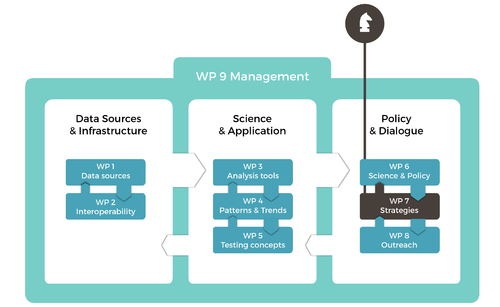 |
 |
 |
 |
 |
 |
 |
 |
 |
WP7 Implementation of GEO BON: strategies and solutions at European and global levels

Objectives
-
To develop strategies for future integrated biodiversity and Earth observation information generation and management
-
To facilitate / improve future biodiversity assessments across broader scales
-
To design templates for future integrated information infrastructures at national and international levels
-
To develop new tools and improved procedures for support of CBD and IPBES
- The work of EU BON is relevant not only for the European context, but also for the global context.
- It is important to see the transferability of EU BON results to other societal and biodiversity backgrounds.
- In that respect it is also important to keep in mind, how EU BON can benefit the opinion building process amongst stakeholders and policy makers.
Tasks





- Policy Briefs 1, 2, 3, 4, 5
- GEO BON Technical Series on butterfly monitoring
- Schmeller, D. S., et al., (2015). Towards a global terrestrial species monitoring program. Journal for Nature Conservation, 25: 51-57. doi:10.1016/j.jnc.2015.03.003
- Geijzendorffer, I.R., et al. (2015), How much would it cost to monitor farmland biodiversity in Europe? Journal of Applied Ecology, 53: 140–149. doi: 10.1111/1365-2664.12552
- Publication in collaboration with WP4: Titeux, N., Henle, K., Mihoub, J.-B., Regos, A., Geijzendorffer, I. R., Cramer, W., Verburg, P. H. and Brotons, L. (2016), Biodiversity scenarios neglect future land-use changes. Global Change Biology, 22: 2505–2515. doi: 10.1111/gcb.13272
- Publication in collaboration with the Biodiversity Knowledge project: Livoreil, B., et al., (in press) Biodiversity knowledge synthesis at the European scale: actors and steps. Biodiversity and Conservation. doi: 10.1007/s10531-016-1143-5
- Geijzendorffer, I. R., Regan, E. C., Pereira, H. M., Brotons, L., Brummitt, N., Gavish, Y., Haase, P., Martin, C. S., Mihoub, J.-B., Secades, C., Schmeller, D. S., Stoll, S., Wetzel, F. T., Walters, M. (2015), Bridging the gap between biodiversity data and policy reporting needs: An Essential Biodiversity Variables perspective. Journal of Applied Ecology. doi: 10.1111/1365-2664.12417
Contacts
Wolfgang Cramer  |
Ilse Geijzendorffer  |
|
| WP Leader | ||
| National Center for Scientific Research (CNRS) | National Center for Scientific Research (CNRS) | UNEP-WCMC |
Dirk Schmeller  |
Neil Greenwood  |
|
| Helmholtz Centre for Environmental Research - UFZ | Natural History Museum, London | Museum für Naturkunde Berlin, Germany |




 RSS news
RSS news
 NEWS
NEWS CALENDAR
CALENDAR